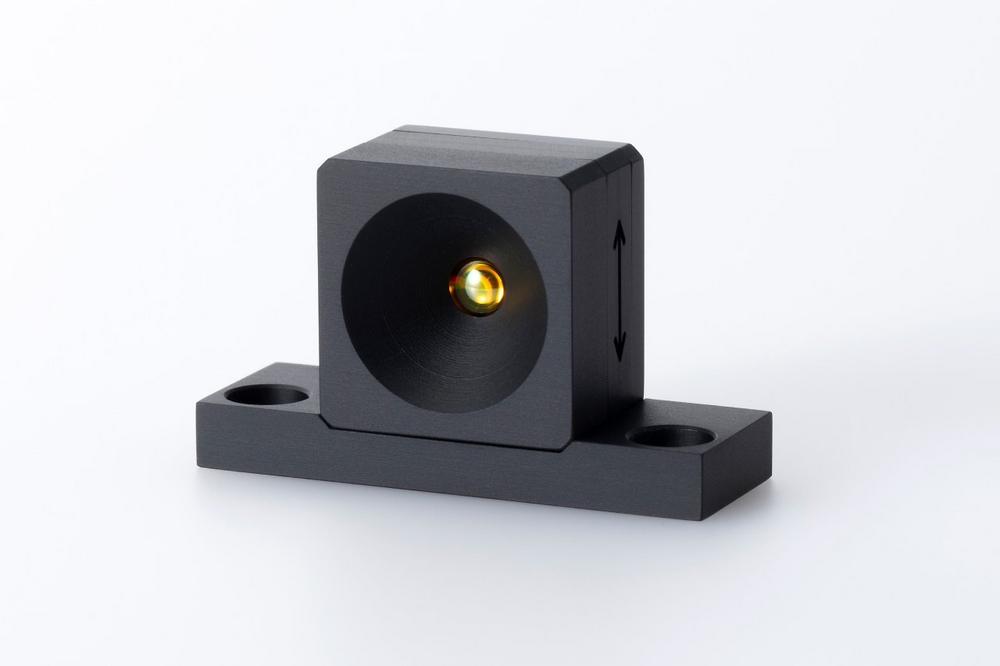Sales of this new QCD will start on October 1, 2021 to research institutes, analytical instrument manufacturers, telecommunications carriers and shipping and conveyor equipment manufacturers, and more.
*1: QCL: A semiconductor laser using a special quantum structure in the light-emitting layer that produces high-power light in the mid-to-far infrared region.
*2: Cut-off frequency: This is the response speed limit of a photodetector and is expressed as the number of times that a single is detected per second.
Product Overview
This product is an uncooled QCD that operates at room temperature and delivers a cut-off frequency of 20 GHz by utilizing a quantum cascade structure for the photosensitive layer. It also has high sensitivity to mid-infrared light at a wavelength of 4.6 μm or micrometers (a micrometer is one-millionth of a meter). Globally, research and development with the long-term goal to create a QCD for practical use, has been ongoing. We are therefore delighted that we have succeeded to develop the world’s first commercial QCD.
At Hamamatsu Photonics, we design, manufacture and sell QCL that utilize a quantum structure for the light emitting layer. While the QCD has a high cut-off frequency achieved through utilizing the quantum effect that results from laminating semiconductor thin films, the QCD had the drawback of low sensitivity compared to other mid-infrared photodetectors. We re-engineered the quantum structure by leveraging quantum structure design technology accumulated over many years and by also applying advanced crystal growth and semiconductor process technologies. These efforts helped us to succeed in increasing the electrical signal quantity generated by incident mid-infrared light, therefore improving the sensitivity and suppressing the dark current*3 that is generated in the photosensor of the QCD even when there is no incident light. At the same time, re-engineering of the circuit design has also reduced the inductance that prevents smooth current flow from the photosensor to the package electrodes. It has minimized the capacitance that stores electric charges, making it easy to read out signals. The result is the world’s first QCD available for commercial and scientific use. This QCD delivers a cut-off frequency of 20 GHz, the world’s highest response time of any mid-infrared photodetectors operating at room temperature, currently available in the market.
Using this QCD as a photodetector for analytical instruments will allow the measurement of various types of chemical reactions including combustion, and explosion for combustion efficiency research, in the order of picoseconds. This detector performs analysis at extremely short time intervals, which has been impossible until now. Since mid-infrared light at 4.6 μm, which is the peak sensitivity wavelength of the QCD, is not easily absorbed by the atmosphere, the QCD is ideally suited to high-speed, large-capacity spatial communications (optical wireless communications) and long-range LiDAR applications and more.
We will continue to develop products that are compatible with other wavelengths in the mid-infrared region. Hamamatsu Photonics are one of only a few companies in the world to manufacture a wide variety of both light sensors and light emitters and can extract their maximum performance, therefore we will be working to open up new markets by offering a combination of QCD and laser products such as QCL.
*3: Dark current is current generated in a photosensor even when there is no incident light, and it is also a source of noise.
Main Product Features
- The world’s first commercial QCD
While the QCD delivers a high cut-off frequency by utilizing the quantum effect achieved from laminating semiconductor nano-level ultra-thin films, the QCD has the drawback of low sensitivity compared to other mid-infrared photodetectors. We re-engineered the quantum structure by leveraging quantum structure design technology which we have accumulated through the development of QCL and by also applying advanced crystal growth and semiconductor process technologies. This helped us succeed in increasing the electrical signal quantity to improve QCD sensitivity and also suppress dark current. In manufacturing ordinary opto-semiconductors, a photosensor chip is usually connected to the package electrodes by metal wiring. However, this time we employed air bridge wiring that makes connections by plating, so that the inductance and capacitance are drastically reduced. The result is the world’s first QCD available for commercial use. Our QCD delivers a cut-off frequency of 20 GHz, the world’s highest response time of any mid-infrared photodetectors operating at room temperature, currently available in the market.
- Compact and easy to handle
This QCD operates at room temperatures and does not require a large cryocooler. It also operates without applying a voltage, so no external power supply is required. This allowed us to make the QCD package compact, at a mere 8 cm3 in cubic volume, so it easily mounts into various types of experimental equipment and analytical instruments. This QCD also includes a focusing lens for easier optical adjustments.
Development background
Currently, the use of high-speed laser measurement technology using visible and near-infrared light is spreading fast. There is also an increasing demand for high-speed laser measurement technology that utilizes mid-infrared light. To keep up with these increasing needs, mid-infrared photodetectors with high cut-off frequencies are already on the market, but typically need to be cooled by a large cryocooler to ensure stable operation. To overcome this, we have been working to develop and produce an uncooled QCD which operates at room temperature, yet delivers a high cut-off frequency.
- Main specifications
Parameter / QCD / Unit
Peak sensitivity wavelength / 4.6 / μm
Photosensitivity (25 °C) / 1 / mA/W
Cut-off frequency (-3dB) /20 / GHz
Weight / 20 / g
Dimensions (W×H×D) / 20 × 20 × 20 / mm
Hamamatsu Photonics Deutschland GmbH
Arzberger Str. 10
82211 Herrsching am Ammersee
Telefon: +49 (8152) 375-0
Telefax: +49 (8152) 375-199
http://www.hamamatsu.com
Public Relations
Telefon: +49 (8152) 375-185
Fax: +49 (8152) 375-199
E-Mail: rfritsch@hamamatsu.de
![]()
